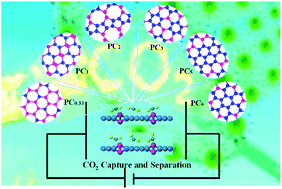Carbon phosphides: promising electric field controllable nanoporous materials for CO2 capture and separation†
Abstract
Materials for high-efficiency CO2 capture and separation are the prerequisites for the CO2 capture and storage strategy that aims to alleviate excessive CO2 emission in the atmosphere. Herein, six carbon phosphides (PCn; n = 0.33, 1, 2, 3, 5, and 6) were systematically evaluated for the first time as promising electric field controllable nanoporous materials for CO2 capture and separation by using density functional theory. The six PCn structures presented high structure stabilities with strong P–C bonds, and high electrical conductivity in an electric field. Without an electric field, weak physisorption of CO2 was observed on PC0.33 and PC3, whereas CO2 would escape from PC6, PC5, PC2, and PC1 surfaces. In electric fields, the adsorption energies of CO2 on all PCn structures were remarkably regulated, and the adsorption of CO2 on PC0.33, PC2, and PC5 underwent a transition from physisorption to chemisorption with increasing the electric field. The adsorption behaviour and energy decomposition analyses identified that PC0.33 and PC5 could significantly enhance the CO2–PCn interaction strength, and PC2 could directly activate CO2 in large electric fields. The adsorption energy differences between CO2 and N2/H2O on PCn indicated the high CO2 selectivity over N2 and the excellent humidity resistance of PCn structures. The maximum adsorption capacity and average interaction analyses confirmed that the best adsorption performance of PC5 corresponded to three CO2 molecules located at a favourable adsorption site with an adsorption strength of 30.77 kJ mol−1 in an electric field of 0.0020 a.u.; the kinetic processes demonstrated that an extremely low energy consumption of 1.4 GJ per ton of CO2 was required for a complete adsorption/desorption cycle under these conditions, which was superior to that of most of the CO2 adsorptions via other methods or materials in electric fields.



 Please wait while we load your content...
Please wait while we load your content...